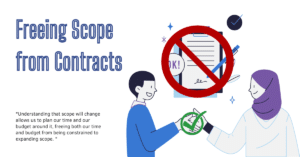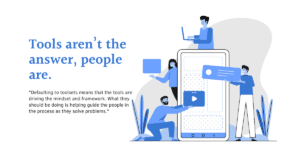Tools are widely regarded as the catalyst to humanities expansion and ascension to the top of the food chain. In the earliest times of our existence, the invention of spears and axes made it easier for us to hunt and chop down trees to create structures. In modern day, we have so many tools that at times it’s hard for us to keep track of what they all do!

What we often forget to remember in our streamlined society is that it isn’t the tool itself that’s important – it’s the way it is used. Tools were invented by us as a form of problem solving. If we encounter issues that our current toolset isn’t solving, why would we continue to use them? It’s fair to say that if all you have is an axe and you’re trying to nail two pieces of wood together, you either need to find a hammer or get creative.
Agile puts individuals and our interactions with them over the traditional tools and processes we follow because your needs in a modern society are unique. While there are tools and processes that may work for you, we can’t assume with certainty that we know what’s best for you until we get to know you and your needs as a company. Defaulting to toolsets means that the tools are driving the mindset and framework. What they should be doing is helping guide the people in the process as they solve problems.
Agile in general doesn’t require any tools, as it is a mindset that has frameworks built with it in mind such as Scrum, Kanban, XP, etc. When we say individuals and interactions over tools and processes, it is our promise to always work alongside the customer as if they are on our team to unify the vision and direction of our projects. Rather than following a rigorous and rigid one-size-fits-all project pipeline, we create the process with our client and choose the tools that will give us our best results.

In fact, when Agile is guiding the process, tools can be created by the team to suite their current needs. Some years ago, this was put to the test when our own managing partner, Peter Graham, was working alongside a small team in the UK for a nationwide identity roll out (National Identity Program). The team was mostly located on the same floor of one building, all communicating with each other on the best steps to take forward. Tasks were written on sticky notes and moved along a board from columns signifying whether they needed to be started, when they were in progress, when they were ready for review, and when they were done. The results of this exercise are still used in the UK’s identity program for their citizens today!
When we in the Agile mindset say, “Individuals and Interactions over Processes and Tools,” we can understand the skepticism. Why would anyone ignore the strategies meant to streamline your process? We meet that skepticism with this question; if a tool or a process requires you to adapt your goals around it, is it serving the end goal or is the end goal compromised for the sake of consistency? In a field that is wildly inconsistent from project to project, we must remember that being on the same page with our clientele is more important than fitting them into a project pipeline. When we base our project timeline in a trust with those we work with, the process invents itself and the results are more satisfying for all involved.



